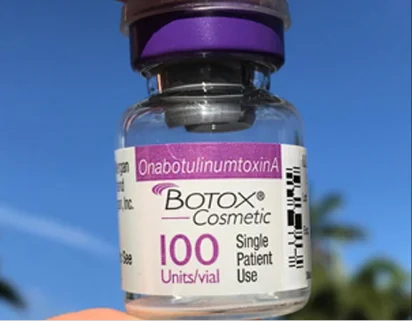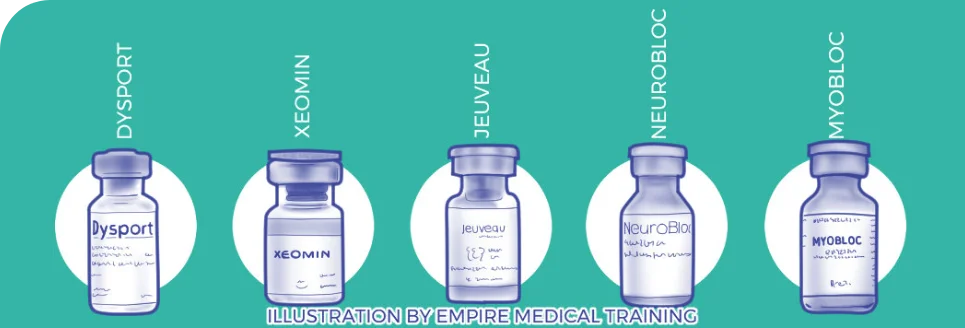Botox® Competitors
By Dr. Stephen Cosentino
PRESIDENT OF EMPIRE MEDICAL TRAINING
Neurotoxins | February 16, 2021

Botox® Competitors
Entry made by
Empire Medical Training
Botox® was the first FDA-approved therapeutic treatment derived from botulinum toxin A (BoNT-A), a potent neurotoxin with a vast range of medicinal
uses. The medication likely needs no introduction: Since the late 1970s, when it was first trialed in human subjects, Botox has been injected many millions of times to treat dozens of conditions, including facial wrinkles,
eyelid droop, bruxism, migraine, general muscle spasticity, bladder control issues, and many more.
Botox (onabotulinum toxin A) is manufactured by Allergan and remains one of that manufacturer’s top-selling (and best-known)
pharmaceutical products. Indeed, Botox remains North America’s most widely used botulinum toxin A treatment. However, since the late 2000s, the FDA has approved several Botox competitors for use in treating specific cosmetic
and musculoskeletal conditions. Although all utilize the same active ingredient and are quite similar chemically, each has subtly different characteristics and effects that appeal to patients and providers alike.
Whether
any particular Botox competitor is “better” than the original is a more difficult question to answer. Different providers may reach different conclusions about Botox and its alternatives based on their own personal preferences,
the conditions in which they specialize, and the attributes of the clinical setting in which they deliver those treatments.
Major Botox Competitors
Botox has several BoNT-A and BoNT-B competitors approved by the U.S. Food and Drug Administration for use in the United States:
- Dysport® (abobotulinum toxin type A)
- Xeomin® (incobotulinum toxin type A)
- Jeuveau® (prabotulinum toxin type A)
- Neurobloc® (botulinum toxin type B)
- Myobloc® (myobotulinum toxin type B)
Each has some common characteristics that contribute to considerable indicational overlap. However, each has a unique set of strengths and weaknesses that make it more or less appropriate in certain situations. For example, Dysport’s lower potency and greater diffusive potential make it suitable for treatment of larger muscle groups or areas of the skin. Jeuveau sells at a lower cost per unit and is marketed to younger audiences seeking cosmetic treatments, making it attractive to practitioners catering to less affluent patients.
Common Characteristics of Botox and All Botox Competitors
First, what do Botox and its competitors have in common?
All four medications — Botox, Dysport, Xeomin, and Jeuveau — have one active ingredient, BoNT-A. All four use this active ingredient to produce the desired cosmetic
and musculoskeletal changes in patients. All are administered by subdermal or intramuscular injection.
Once administered, the BoNT-A toxin works by disrupting nerve signals to the affected muscles,
temporarily relaxing or paralyzing them. Depending on the treatment location (affected muscle group), this may result in visual changes (such as a smoothing of the skin or firming of the muscles) and/or the temporary reduction
or elimination of symptoms such as muscle pain, muscle spasms, and migraine.
Botox and its competitors do have some subtle differences in molecular weight (concentration), inactive ingredients, storage requirements,
and effectiveness duration, among others. Let’s go through each in turn.

Botox Competitor #1: Dysport
Dysport is manufactured by Medicis Pharmaceutical. With a slightly lower molecular weight and a different protective protein makeup, Dysport achieves greater diffusion within patient tissues. It’s therefore preferred by some practitioners for procedures involving larger muscle groups or treatment areas, such as the masseter muscles (for the treatment of involuntary jaw clenching) and the forehead.
Dysport Characteristics
Notably, Dysport contains small amounts of lactose and milk proteins, which may make it unsuitable for patients with dairy allergies. Although the science is not yet conclusive on this point, Dysport’s higher rate of diffusion may result in quicker onset and dissipation of therapeutic or cosmetic effects on treated muscles. Accordingly, patients may need to repeat treatment more often than with Botox and some other competitors. Dysport’s per-unit cost is comparable to Botox’s, but more frequent treatments may increase the overall cost to the patient.
Botox Competitor #2: Xeomin
Xeomin is manufactured by Merz, an Allergan competitor. The medication was first approved by the FDA for the treatment of frown lines, a common cosmetic application. More recently, the FDA has approved its use for the treatment of muscle spasticity and excessive drooling.
Xeomin Characteristics
Xeomin is notable for the absence of complexing proteins, a feature of Botox and some Botox competitors. This eliminates the need for refrigeration before use, which has two benefits: reduced complexity for practitioners and increased comfort for patients
during and immediately following injection. Xeomin may also be effective at lower doses than Botox and Dysport and may be suitable for patients who have acquired resistance to other BoNT-A treatments, although it is possible
for patients to acquire resistance to Xeomin as well.
Therapeutically, Xeomin is similar to Botox. Its effects may take longer to become apparent (three to five days or longer) but are of comparable duration.
Botox Competitor #3: Jeuveau
Jeuveau is a newer BoNT-A treatment approved for cosmetic usage (specifically, the treatment of frown lines). Manufactured by Evolus, Jeuveau is notable for its relatively low cost (up to 30% lower than Botox), which enhances its appeal for cost-conscious
patients and those seeking one-off treatments. It’s also easy to substitute for Botox due to the two medications’ identical molecular weights and comparable duration of efficacy.
Jeuveau’s
greatest drawback is its relatively narrow range of indications. Unlike Botox, it’s not approved for therapeutic procedures like migraine or bruxism (involuntary jaw clenching) treatments. This could change with further study of Jeuveau’s efficacy and safety in therapeutic applications, but it’s a key limitation today.
Considerations Around Switching to Botox Competitors
Botox faces real competition from a growing number of safe, effective competitors. While newer competitors like Jeuveau are not yet approved for the same broad range of procedures as Botox itself, the trendline is clear. Physicians and aestheticians will
have more choice next year, more choice still the year after, and so on for the foreseeable future.
At the same time, Botox has proven itself as a reliable, effective, and safe treatment
time and again. Many providers see no need to switch from a known quantity (literally and figuratively). On the other hand, Botox competitors are fairly similar to one another, so the learning curve inherent in any new therapy
is not a major obstacle to adoption. This makes the decision easier for providers contemplating adding a Botox competitor or switching away from Botox altogether.
Those that do choose to make the switch or addition
typically do so in response to the following considerations:
- Cost to the patient and practice
- Patient comfort and preference
- Efficacy and dosing
- Ease of storage
- Repeat patients’ resistance to Botox
- Diversification away from a single BoNT-A or -B therapeutic


